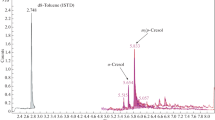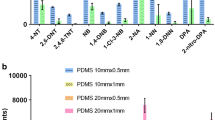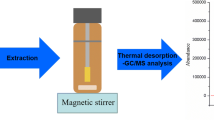Abstract
The analysis of organic pollutants in environmental water samples requires a pre-concentration step. Pre-concentration techniques such as stir bar sorptive extraction (SBSE) have gained popularity since they minimise the use of toxic organic solvents and can be considered as green analytical techniques. Similar to other pre-concentration techniques, one of the problems when SBSE is used is the matrix effect, which often occurs during the analysis of environmental water samples such as estuarine or wastewater samples. The present work studied the matrix effect during SBSE coupled to in-tube derivatisation–thermal desorption (TD)–gas chromatography–mass spectrometry for the determination of several endocrine disruptor compounds, such as alkylphenols, bisphenol A, estrogens and sterols, in environmental water samples, after optimisation of the major variables affecting the determination. Variables such as the addition of methanol or an inert salt to the donor phase, the extraction temperature, the volume of the donor phase, the stirring rate and the extraction time were studied during the SBSE optimisation. In the case of the in-tube derivatisation and TD step, the volume of the derivatisation reagent (N,O-bis(trimethylsilyl)triufloroacetamide with 1% of trimethylchlorosilane (BSTFA + 1% TMCS)) and the cryo-focusing temperature were fixed (2 μL and −50 °C, respectively) according to a consensus between maximum signal and optimal operation conditions. Good apparent recovery values (78–124%) were obtained for most of the analytes in Milli-Q water, except for 4-tert-octylphenol (4-tOP), which showed apparent recovery values exceeding 100%. Precision (n = 4) was in the 2–27%, and method detection limits were in the low nanogrammes per litre level for most of the analytes studied. The matrix effect was studied using two different approaches. On the one hand, Milli-Q water samples were spiked with humic acids, and apparent recovery values were studied with and without correction with the corresponding deuterated analogue. On the other hand, estuarine water and wastewater samples were spiked with known concentrations of target analytes, and apparent recoveries were studied as explained above. In general, the matrix effect could be corrected with the use of deuterated analogues, except for 4-tOP and nonylphenols for which [2H4]-n-nonylphenol did not provide good corrections.






Similar content being viewed by others
References
Coquery M, Morin A, Bécue A, Lepot B (2005) Trends Anal Chem 24:117–127
Guigues N, Berho C, Roy S, Foucher J-C, Fouillac A-M (2007) Trends Anal Chem 26:268–273
Richardson SD (2007) Anal Chem 79:4295–4324
WHO/IPCS (2002) Global assessment of the state-of-science of endocrine disruptors. World Health Organization/International Program on Chemical safety. WHO/PCS/EDC/02.2. Available at http://www.who.int/emerg_site/edc/global_edc_ch5.pdf
Tan BLL, Hawker DW, Müller JF, Tremblay LA, Chapman HF (2008) Water Res 42:404–412
Barceló D, Petrovic M (2007) Trends Anal Chem 26:647–649
Gibson R, Tyler CR, Hill EM (2005) J Chromatogr A 1066:33–40
David F, Tienpont B, Sandra P (2003) LC-GC Europe 16:1–7
Bruzzoniti MC, Sarzanini C, Mentasti E (2000) J Chromatogr A 902:289–309
Kot A, Zabiegala B, Namiesnik J (2000) Trends Anal Chem 19:446–459
Arthur CL, Pawliszyn J (1990) Anal Chem 62:2145–2148
Baltussen E, David F, Sandra P, Janssen H-G, Cramers C (1999) Anal Chem 71:5193–5198
Carpinteiro J, Rodríguez I, Cela R (2004) Anal Bioanal Chem 380:853–857
Centineo G, Blanco González E, García Alonso JI, Sanz-Medel A (2006) J Mass Spectrom 41:77–83
Mishra S, Tripathi RM, Bhalke S, Shukla VK, Puranik VD (2005) Anal Chim Acta 551:192–198
León VM, Llorca-Pórcel J, Álvarez B, Cobollo MA, Muñoz S, Valor I (2006) Anal Chim Acta 558:261–266
Popp P, Keil P, Montero L, Rückert M (2005) J Chromatogr A 1071:155–162
Montero L, Popp P, Paschke A, Pawliszyn J (2004) J Chromatogr A 1025:17–26
Baltussen E, Sandra P, David F, Cramers C (1999) J Microcolumn Sep 11:737–747
Baltussen E, Cramers CA, Sandra PJF (2002) Anal Bioanal Chem 373:3–22
Lancas FM, Queiroz MEC, Grossi P, Olivares IRB (2009) J Sep Sci 32:813–824
David F, Sandra P (2007) J Chromatogr A 1152:54–69
Kawaguchi M, Ito R, Saito K, Nakazawa H (2006) J Pharm Biomed Anal 40:500–508
Sánchez-Rojas F, Bosch-Ojeda C, Cano-Pavón JM (2009) Chromatographia 69:79–94
Prieto A, Basauri O, Rodil R, Usobiaga A, Fernández LA, Etxebarria N, Zuloaga O (2010) J Chromatogr A 1217:2642–2666
Kawaguchi M, Sakui N, Okanouchi N, Ito R, Saito K, Nakazawa H (2005) J Chromatogr A 1062:23–29
Montero L, Conradi S, Weiss H, Popp P (2005) J Chromatogr A 1071:163–169
Kawaguchi M, Ishii Y, Sakui N, Okanouchi N, Ito R, Saito K, Nakazawa H (2005) Anal Chim Acta 533:57–65
Nakamura S, Daishima S (2004) J Chromatogr A 1038:291–294
Kawaguchi M, Inoue K, Yoshimura M, Sakui N, Okanouchi N, Ito R, Yoshimura Y, Nakazawa H (2004) J Chromatogr A 1041:19–26
Stopforth A, Burger BV, Crouch AM, Sandra P (2007) J Chromatogr B 856:156–164
Kawaguchi M, Sakui N, Okanouchi N, Ito R, Saito K, Izumi S-I, Makino T, Nakazawa H (2005) J Chromatogr B 820:49–57
Kawaguchi M, Inoue K, Yoshimura M, Ito R, Sakui N, Okanouchi N, Nakazawa H (2004) J Chromatogr B 805:41–48
Kawaguchi M, Ito R, Sakui N, Okanouchi N, Saito K, Nakazawa H (2006) J Chromatogr A 1105:140–147
Quintana JB, Rodil R, Muniategui-Lorenzo S, Lopez-Mahia P, Prada-Rodriguez D (2007) J Chromatogr A 1174:27–39
Van Hoeck E, Canale F, Cordero C, Compernolle S, Bicchi C, Sandra P (2009) Anal Bioanal Chem 393:907–919
Bicchi C, Schilirò T, Pignata C, Fea E, Cordero C, Canale F, Gilli G (2009) Sci Total Environ 407:1842–1851
Brossa L, Marcé RM, Borrull F, Pocurull E (2005) Chromatographia 61:61–65
Giordano A, Fernández-Franzón M, Ruiz MJ, Font G, Picó Y (2009) Anal Bioanal Chem 393:1733–1743
Chaves AR, Silva SM, Queiroz RHC, Lanças FM, Queiroz MEC (2007) J Chromatogr B 850:295–302
Rodil R, Moeder M (2008) J Chromatogr A 1179:81–88
Almeida C, Nogueira JMF (2006) J Pharm Biomed Anal 41:1303–1311
Hu Y, Zheng Y, Zhu F, Li G (2007) J Chromatogr A 1148:16–22
Bourdat-Deschamps M, Daudin JJ, Barriuso E (2007) J Chromatogr A 1167:143–153
Ochiai N, Sasamoto K, Takino M, Yamashita S, Daishima S, Heiden A, Hoffman A (2001) Analyst 126:1652–1657
León VM, Álvarez B, Cobollo MA, Muñoz S, Valor I (2003) J Chromatogr A 999:91–101
Melo LP, Nogueira AM, Lanças FM, Queiroz MEC (2009) Anal Chim Acta 633:57–64
Costa Queiroz RH, Bertucci C, Malfará WR (2008) J Pharm Biomed Anal 48:428–434
Liu W, Hu Y, Zhao J, Xu Y, Guan Y (2005) J Chromatogr A 1095:1–7
Shareef A, Angove MJ, Wells JD (2006) J Chromatogr A 1108:121–128
Hernando MD, Mezcua M, Gómez MJ, Malato O, Agüera, Fernández-Alba AR (2004) J Chromatogr A 1047:129–135
Prieto A, Schrader S, Moeder M (2010) J Chromatogr A 1217:6002–6011
Beck IC, Bruhn R, Gandrass J, Ruck W (2005) J Chromatogr A 1090:98–106
Vega-Morales T, Sosa-Ferrera Z, Santana-Rodríguez JJ (2010) J Hazard Mater 183:701–711
Viglino L, Aboulfadl K, Prévost M, Sauvé S (2008) Talanta 76:1088–1096
Sandra P, Tienpont B, Vercammen J, Tredoux A, Sandra T, David F (2001) J Chromatogr A 928:117–126
Benijts T, Vercammen J, Dams R, Pham Tuan H, Lambert W, Sandra P (2001) J Chromatogr B 755:137–142
Phillips P, Chalmers A (2009) J Am Water Resour As 45:45–57
Acknowledgements
This work was financially supported by the Spanish Ministry of Science and Innovation through the CTQ2008-02775/BQU project and the University of the Basque Country through the UNESCO09/03 project. A. Prieto is grateful to the Basque Government for her post-doctoral fellowship. A. Iparraguirre is grateful to the Basque Government for her pre-doctoral fellowship.
Author information
Authors and Affiliations
Corresponding author
Rights and permissions
About this article
Cite this article
Iparraguirre, A., Prieto, A., Navarro, P. et al. Optimisation of stir bar sorptive extraction and in-tube derivatisation–thermal desorption–gas chromatography–mass spectrometry for the determination of several endocrine disruptor compounds in environmental water samples. Anal Bioanal Chem 401, 339–352 (2011). https://doi.org/10.1007/s00216-011-5074-4
Received:
Revised:
Accepted:
Published:
Issue Date:
DOI: https://doi.org/10.1007/s00216-011-5074-4




